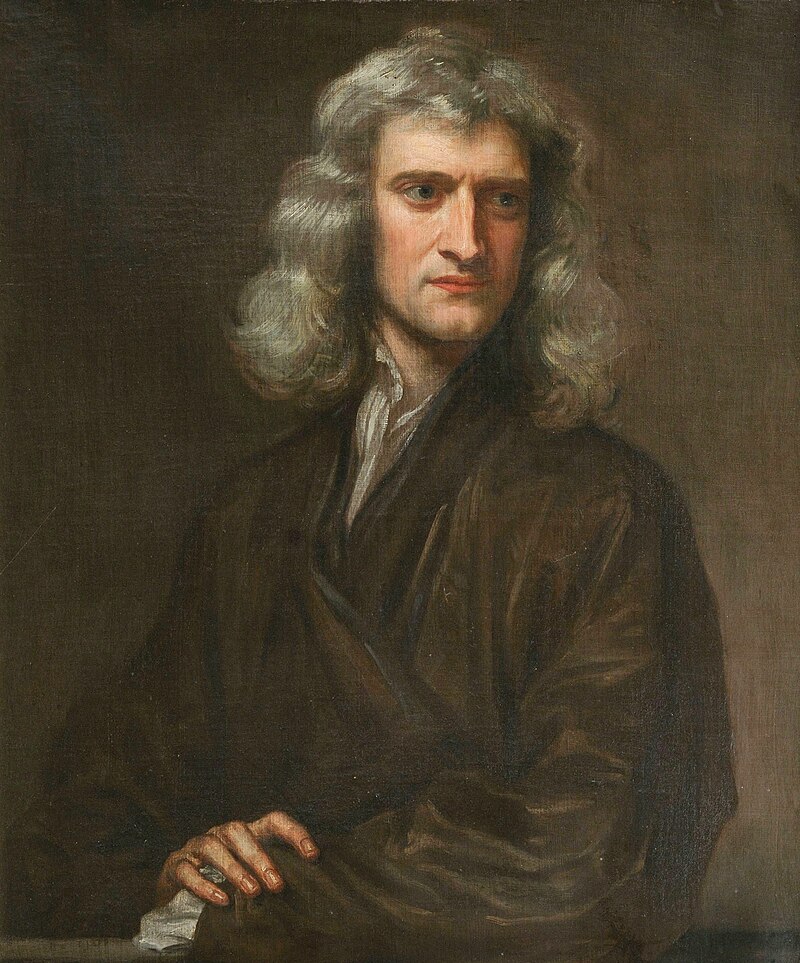Isaac Newton (1643-1727) was a renowned English mathematician, physicist, and astronomer. He is best known for formulating the laws of motion and the law of universal gravitation. Newton’s contributions laid the foundation for classical mechanics and greatly influenced the scientific revolution.
Early Life and Education
Isaac Newton’s early life and education were marked by adversity, academic prowess, and the pursuit of knowledge. Born prematurely on December 25, 1642, in Woolsthorpe, Lincolnshire, England, Newton entered a world where his father had passed away before his birth. His mother, Hannah Ayscough Newton, remarried when he was three, leaving him to be raised by his maternal grandmother while she pursued her second marriage. This early familial dynamic played a significant role in shaping Newton’s formative years.
In his early childhood, Newton’s intellectual curiosity began to manifest. His aptitude for learning and mechanical tinkering became evident, hinting at the scientific genius that would later define his legacy. However, financial constraints nearly derailed his education. The death of his stepfather provided a pivotal turning point, allowing Newton’s mother to return to Woolsthorpe and recognize her son’s academic potential.
Newton attended the King’s School in Grantham, where his academic abilities flourished. He displayed an early interest in mechanics and technology, often experimenting with various devices and demonstrating an innate talent for solving mathematical problems. It became apparent that Newton was destined for intellectual pursuits beyond the ordinary.
In 1661, at the age of 18, Newton entered the University of Cambridge’s Trinity College, a decision that would profoundly shape his future. His enrollment was initially as a “subsizar,” a student who performed menial tasks to offset tuition costs. Despite the humble beginnings, Newton’s exceptional academic performance caught the attention of his professors, leading to financial assistance that allowed him to focus on his studies.
At Cambridge, Newton delved into the works of influential thinkers like René Descartes and Galileo Galilei. His rigorous engagement with mathematical and scientific ideas laid the groundwork for the profound contributions he would make to these fields. Newton’s thirst for knowledge and keen intellect set him apart, earning him the distinction of a scholar with unparalleled potential.
While at Cambridge, Newton’s attention gravitated toward mathematics. He immersed himself in the study of Euclidean geometry, algebra, and other mathematical disciplines. His early interest in mechanics also found expression through the study of natural philosophy. This period of intense intellectual exploration laid the foundation for his groundbreaking contributions to various scientific disciplines.
Newton’s academic journey at Cambridge unfolded during a tumultuous period in English history. The mid-17th century witnessed political upheavals, including the English Civil War and the execution of King Charles I. These events had a profound impact on the academic environment, with universities experiencing disruptions and shifts in leadership. Despite these challenges, Newton’s commitment to learning and inquiry remained unwavering.
In 1665, while the university temporarily closed due to the bubonic plague, Newton returned to Woolsthorpe. This period, often referred to as his “annus mirabilis” or “miracle year,” proved to be a watershed moment in his life. During this time of isolation, Newton made groundbreaking discoveries that would reshape the landscape of physics and mathematics.
One of Newton’s major achievements during this period was the development of calculus, a mathematical framework that he used to solve problems related to motion and change. Although contemporaneous with the German mathematician Gottfried Wilhelm Leibniz, the priority dispute over the invention of calculus persisted for years.
Newton also explored optics and conducted experiments with light and prisms, unraveling the mysteries of color. His work in optics culminated in the publication of “Opticks” in 1704, where he presented his theories on the nature of light and color, along with observations on refraction and reflection.
Newton’s return to Cambridge in 1667 marked the beginning of his rise within academic circles. He was appointed as a Fellow of Trinity College and later became Lucasian Professor of Mathematics, a prestigious position previously held by luminaries like Isaac Barrow. Newton’s lectures and writings during this time showcased his growing influence in the academic community.
Newton’s achievements in mathematics and physics culminated in the publication of the Principia in 1687. This seminal work laid out the laws of motion, the law of universal gravitation, and a comprehensive mathematical framework for understanding the physical world. The Principia cemented Newton’s status as a preeminent figure in science and left an indelible mark on the scientific revolution.
Despite his profound contributions to academia, Newton’s personal life was marked by eccentricities and occasional periods of social withdrawal. His personality, often described as complex, reflected a blend of intense focus on his work and moments of contentious interactions with contemporaries.
Isaac Newton’s early life and education form a narrative of resilience, intellectual curiosity, and a relentless pursuit of knowledge. From his humble beginnings in Woolsthorpe to his groundbreaking discoveries at Cambridge, Newton’s journey laid the groundwork for his enduring legacy as one of the greatest scientists in history. His contributions not only advanced the understanding of the physical world but also set a standard for scientific inquiry that continues to inspire generations of scholars.
Scientific Achievements
Isaac Newton’s scientific achievements are a testament to his genius and profound impact on the foundations of physics, mathematics, and astronomy. His groundbreaking work, particularly detailed in “Mathematical Principles of Natural Philosophy” (Principia) and “Opticks,” laid the groundwork for classical mechanics, the laws of motion, the law of universal gravitation, and our understanding of optics.
Newton’s most enduring contribution is undoubtedly the formulation of the three laws of motion. Published in the Principia in 1687, these laws provide a comprehensive framework for understanding the motion of objects. The first law states that an object at rest will remain at rest, and an object in motion will remain in motion unless acted upon by a net external force. The second law quantifies the relationship between an object’s mass, its acceleration, and the applied force. The third law asserts that for every action, there is an equal and opposite reaction.
These laws revolutionized physics, providing a unified description of motion that could explain phenomena ranging from falling apples to planetary orbits. Newton’s laws of motion became foundational principles, shaping the trajectory of classical mechanics and forming the basis for subsequent advancements in the field.
In addition to the laws of motion, Newton’s law of universal gravitation stands as one of the cornerstones of classical physics. Published in the Principia, this law describes the gravitational force between two objects as directly proportional to the product of their masses and inversely proportional to the square of the distance between their centers. Newton’s law of universal gravitation provided a unified explanation for both terrestrial and celestial phenomena, offering a comprehensive understanding of the forces governing the motion of celestial bodies.
The impact of the law of universal gravitation extended beyond theoretical physics. It enabled accurate predictions of celestial events and orbits, laying the foundation for advancements in celestial mechanics. Newton’s law of gravitation became a fundamental tool for astronomers, allowing them to describe and predict the motions of planets and other celestial bodies with unprecedented accuracy.
Newton’s work in optics, as detailed in “Opticks,” further demonstrated his scientific prowess. In the early 1670s, he conducted experiments with light and prisms, revealing the phenomenon of dispersion where white light could be decomposed into a spectrum of colors. Newton’s experiments and observations laid the groundwork for the understanding of color and light, challenging prevailing theories and offering a new perspective on the nature of optics.
In “Opticks,” published in 1704, Newton presented his theories on the nature of light and color. He proposed that white light is composed of a spectrum of colors and explored the properties of light, including reflection and refraction. Newton’s work in optics significantly advanced our understanding of the behavior of light, influencing subsequent developments in the field and contributing to the wave-particle duality theory that emerged in the 19th and 20th centuries.
Newton’s contributions to mathematics are equally significant, particularly his development of calculus. Although there was a priority dispute with Gottfried Wilhelm Leibniz over the invention of calculus, Newton’s work in this field became an essential tool in physics and mathematics. Calculus provided a powerful mathematical framework for describing and analyzing motion, change, and rates of change—fundamental concepts in the study of the physical world.
Newton’s impact on mathematics extended to his development of the binomial theorem and his contributions to the study of infinite series. His work in these areas not only facilitated mathematical calculations but also laid the groundwork for future developments in mathematical analysis.
Beyond his specific scientific contributions, Newton played a crucial role in advancing the scientific method. His emphasis on systematic experimentation, empirical observation, and mathematical analysis became a model for scientific inquiry. The Principia, in particular, exemplified Newton’s commitment to rigorously testing hypotheses and deriving conclusions based on evidence—a methodology that continues to guide scientific research to this day.
In addition to his scientific pursuits, Newton held various public positions, showcasing the practical applications of his scientific insights. He served as a Member of Parliament and later as the Master of the Mint, where he was instrumental in reorganizing the British currency. Newton’s engagement with practical matters demonstrated the real-world impact of scientific thinking and problem-solving.
Despite his towering achievements, Newton’s life was not without challenges and complexities. His personality was marked by periods of intense focus on his work, as well as moments of social withdrawal and conflict with contemporaries. Newton’s private life and interpersonal relationships reflected the intricate interplay of his intellectual pursuits and personal struggles.
Isaac Newton’s scientific achievements form a monumental legacy that continues to shape our understanding of the physical world. His laws of motion, law of universal gravitation, contributions to optics, and development of calculus have left an indelible mark on physics and mathematics. Newton’s work not only advanced scientific knowledge but also set a standard for the scientific method, inspiring generations of researchers to explore the mysteries of the universe with curiosity and rigor.
Principia Mathematica
“Philosophiæ Naturalis Principia Mathematica,” commonly known as the Principia Mathematica, is Isaac Newton’s magnum opus, published in 1687. This groundbreaking work laid the foundation for classical mechanics, revolutionizing the scientific understanding of motion, gravity, and celestial mechanics. The Principia is regarded as one of the most influential scientific books ever written and represents a pinnacle in the history of physics.
The Principia consists of three books, each addressing specific aspects of Newton’s comprehensive system of natural philosophy. The first book, titled “Mathematical Principles of Natural Philosophy,” introduces the three laws of motion—fundamental principles that govern the motion of objects. These laws provided a unified framework for understanding both terrestrial and celestial phenomena, establishing a universal language for describing the dynamics of the physical world.
Newton’s first law states that an object at rest will remain at rest, and an object in motion will remain in motion at a constant velocity unless acted upon by a net external force. The second law relates the force acting on an object to its mass and acceleration, expressing the fundamental relationship between force and motion. The third law asserts that for every action, there is an equal and opposite reaction—a principle that applies to the interaction of all objects in the universe.
These laws formed the cornerstone of classical mechanics, offering a coherent and systematic explanation for a wide range of physical phenomena. Newton’s mathematical formulation of these laws allowed for precise predictions and calculations, transforming the study of motion into a quantitative science.
The second book of the Principia delves into fluid motion and the resistance of fluids. Newton explored the behavior of fluids, providing insights into the motion of liquids and gases under various conditions. While the second book is less well-known than the first, it demonstrated Newton’s versatility in addressing a diverse array of physical phenomena.
The third book, titled “The System of the World,” is dedicated to celestial mechanics and the law of universal gravitation. In this section, Newton presents his revolutionary theory of gravity, proposing that every object in the universe attracts every other object with a force proportional to the product of their masses and inversely proportional to the square of the distance between their centers. The law of universal gravitation provided a unified explanation for the motion of celestial bodies, reconciling the orbits of planets with a single, underlying principle.
One of the most remarkable aspects of the Principia is Newton’s use of mathematical tools, particularly his development of calculus. While the calculus was independently developed by Newton and the German mathematician Gottfried Wilhelm Leibniz, the Principia served as a platform for showcasing the power and utility of this mathematical framework. Newton’s use of calculus enabled him to express his laws of motion and the law of universal gravitation in precise mathematical terms, facilitating the quantitative analysis of physical phenomena.
The impact of the Principia extended far beyond the scientific community. Its publication marked a turning point in the history of science, providing a methodical and systematic approach to understanding the natural world. The Principia laid the groundwork for the scientific revolution, emphasizing the importance of empirical observation, experimentation, and mathematical analysis in the pursuit of knowledge.
Newton’s work was met with both admiration and criticism. The clarity and elegance of his explanations, coupled with the predictive power of his laws, garnered widespread acclaim. However, the intricacies of the mathematical reasoning and the novel nature of the ideas presented in the Principia also led to challenges in comprehension and acceptance.
The Principia Mathematica represents a synthesis of Newton’s diverse intellectual pursuits, incorporating his contributions to mathematics, physics, and astronomy into a cohesive and revolutionary system. The impact of the Principia reverberates through the centuries, influencing subsequent generations of scientists and serving as a foundational text for the study of classical mechanics.
Conflict with Leibniz
The conflict between Isaac Newton and Gottfried Wilhelm Leibniz over the invention of calculus is one of the most famous disputes in the history of mathematics. This controversy, often referred to as the “calculus priority dispute,” unfolded in the late 17th century and has left a lasting impact on the perception of both mathematicians’ contributions to this fundamental branch of mathematics.
The origins of the conflict can be traced back to the independent development of calculus by Newton and Leibniz during the same period. Calculus, a mathematical framework for dealing with rates of change and the accumulation of quantities, was a revolutionary development with profound implications for various scientific fields, including physics and engineering.
Isaac Newton began working on the mathematical methods that would later be recognized as calculus in the mid-1660s. His efforts were closely tied to his investigations into physics and celestial mechanics. Newton’s approach involved the method of fluxions, a conceptual framework that dealt with quantities in motion and their rates of change. He used this method to develop a systematic approach to calculus, allowing him to solve problems related to motion, acceleration, and the computation of areas under curves.
Meanwhile, in the late 1670s, the German mathematician and philosopher Leibniz was independently developing his own notation and methods for calculus. Leibniz introduced the integral sign (∫) and the differential notation (dy/dx), which are still used today. Leibniz’s notation and approach were more accessible and user-friendly than Newton’s fluxions, making calculus more widely adoptable.
The controversy ignited in the early 18th century when both Newton and Leibniz published their respective works on calculus. Newton’s major contributions were outlined in his “Method of Fluxions” in the 1670s, but he did not publish this work until much later. On the other hand, Leibniz published his first paper on calculus, “Nova Methodus pro Maximis et Minimis,” in 1684.
The timing of the publications and the differing notations led to a heated dispute over priority. Newton and his followers, including some prominent mathematicians of the time, argued that Newton had developed the calculus first, using the method of fluxions. Newton was vocal about his claim, asserting that Leibniz had taken the ideas from him without proper acknowledgment.
Leibniz, on the other hand, defended his work vigorously. He argued that he had independently developed calculus and that his notation was distinctly different from Newton’s method of fluxions. Leibniz contended that his approach was more intuitive and user-friendly, emphasizing the clarity and simplicity of his notation.
The dispute escalated as supporters on both sides engaged in a war of words through letters, publications, and personal interactions. The scientific community became polarized, with mathematicians taking sides in what became a bitter and public controversy. Notable figures, including the French mathematician Pierre-Simon Laplace, sided with either Newton or Leibniz, further fueling the conflict.
In 1711, the Royal Society formed a committee to investigate the priority dispute. The committee, largely composed of Newton’s supporters, concluded that Newton was the first inventor of calculus. This verdict, however, did not quell the controversy, as Leibniz and his followers rejected the committee’s findings.
The calculus priority dispute had broader implications beyond the personal rivalry between Newton and Leibniz. It divided the mathematical community and hindered collaboration and communication between mathematicians for many years. The dispute also contributed to a delay in the widespread acceptance and dissemination of calculus.
The controversy persisted even after Newton’s death in 1727 and Leibniz’s death in 1716. It wasn’t until the 19th century that a more nuanced and objective assessment of the contributions of Newton and Leibniz to calculus emerged. Mathematicians such as Augustin-Louis Cauchy and Karl Weierstrass recognized the independent significance of both approaches and emphasized the collective nature of mathematical progress.
Ultimately, the dispute over calculus priority was a complex and multifaceted issue. While Newton and Leibniz independently developed calculus, their different notations and approaches reflected distinct mathematical insights. Both mathematicians made profound contributions to the field, and today calculus is often taught using a combination of their notations and methods, acknowledging the richness of both traditions.
In the annals of mathematical history, the calculus priority dispute serves as a cautionary tale about the challenges of determining priority and the importance of fostering a collaborative and open scientific community. It also highlights the human aspect of scientific discovery, where rivalries and personal conflicts can sometimes overshadow the collective progress of knowledge. Despite the contentious history, the legacy of Newton and Leibniz endures in the foundational principles of calculus that continue to shape the landscape of mathematics and science.
Personal Life
Isaac Newton’s personal life was marked by a complex interplay of intellectual brilliance, social isolation, and occasional bouts of eccentric behavior. Born prematurely on December 25, 1642 (Julian calendar), in Woolsthorpe, Lincolnshire, England, Newton faced early challenges that shaped his character and influenced the trajectory of his life.
Newton’s father died before his birth, and his mother remarried when he was three. Raised by his maternal grandmother while his mother pursued her second marriage, Newton’s early years were marked by a sense of familial detachment. This period of relative solitude may have contributed to the development of his introspective and independent nature.
In his formative years, Newton attended the King’s School in Grantham, where he exhibited exceptional academic prowess. His intellectual curiosity and a penchant for mechanical tinkering hinted at the scientific genius that would later define his legacy. Despite these qualities, financial constraints initially threatened to disrupt his education until the death of his stepfather allowed his mother to return to Woolsthorpe, recognizing her son’s academic potential.
Newton’s enrollment at the University of Cambridge’s Trinity College in 1661 marked the beginning of a new chapter. At Cambridge, he immersed himself in the study of mathematics and natural philosophy, laying the groundwork for the groundbreaking discoveries that would shape his reputation as one of history’s greatest scientists.
While Newton’s professional life flourished, his personal life was characterized by a complex and sometimes tumultuous nature. Known for his intense focus on his work, Newton exhibited periods of social withdrawal and a tendency to immerse himself in solitary pursuits. His dedication to his studies and scientific inquiries often took precedence over social interactions.
Newton’s personality was marked by a combination of brilliance and reticence. He had a reputation for being reserved and introspective, with a meticulous and methodical approach to his work. Newton’s notebooks reveal the depth of his intellectual pursuits, showcasing his rigorous thought processes and commitment to empirical observation.
Despite his academic achievements, Newton faced personal challenges and conflicts. His tenure as Lucasian Professor of Mathematics at Cambridge brought both recognition and demands on his time. Newton’s role in university governance and his involvement in academic disputes occasionally placed him at odds with colleagues, contributing to a complex social dynamic.
In the late 1670s and early 1680s, Newton experienced a period of intense intellectual productivity, known as his “annus mirabilis” or “miracle year.” During this time, he made groundbreaking contributions to mathematics, optics, and physics. Newton’s development of calculus, his work on the nature of light and color, and the formulation of the laws of motion occurred in rapid succession, demonstrating the breadth of his intellectual capabilities.
The publication of the Principia Mathematica in 1687 solidified Newton’s reputation as a preeminent scientist. However, the intense focus on his work and his tendency to withdraw from social engagements sometimes fueled misconceptions about his character. Newton’s dedication to his studies and scientific pursuits often led him to prioritize intellectual endeavors over personal relationships.
In 1696, Newton’s personal life took a different turn when he accepted the position of Warden of the Royal Mint. This marked a transition from his academic career to a role with significant administrative responsibilities. Newton’s tenure at the Mint was characterized by his efforts to combat counterfeiting and reorganize the British currency. His pragmatic approach to these matters demonstrated a practical side of Newton that extended beyond theoretical pursuits.
Newton’s later years included further public service, as he became Master of the Mint in 1699. Despite his involvement in administrative roles, he continued to engage with scientific matters, publishing works on mathematics and pursuing his interests in alchemy and theology.
In his private life, Newton never married and led a largely solitary existence. His personal relationships were limited, and he maintained a degree of distance from others. Newton’s focus on his work, combined with his reserved nature, contributed to the perception of him as a somewhat enigmatic figure.
Newton’s death on March 20, 1727, marked the end of a life characterized by intellectual brilliance and a complex personal journey. His legacy endures in the principles of physics and mathematics that bear his name, but the nuances of his personal life add a layer of humanity to the narrative of a scientific giant. Newton’s story serves as a reminder of the intricate relationship between the personal and professional aspects of a brilliant mind, leaving a lasting imprint on the history of science and the understanding of the universe.
Legacy
Isaac Newton’s legacy is indelibly imprinted on the fabric of human knowledge, spanning mathematics, physics, astronomy, and the scientific method. His groundbreaking contributions to these fields have left an enduring impact, shaping the way we understand the physical world and influencing subsequent generations of scientists and thinkers.
Newton’s most celebrated work, “Philosophiæ Naturalis Principia Mathematica” (Principia), published in 1687, stands as a monumental achievement in the history of science. In Principia, Newton formulated the three laws of motion and the law of universal gravitation, providing a comprehensive and mathematically rigorous framework for understanding the dynamics of the physical universe. These laws became the cornerstone of classical mechanics, revolutionizing physics and serving as the foundation for subsequent developments in the field.
The laws of motion articulated in the Principia not only explained the motion of objects on Earth but also provided a universal language to describe the orbits of celestial bodies. Newton’s law of universal gravitation demonstrated that the force governing the fall of an apple near his childhood home was the same force dictating the movements of planets in the heavens. This unification of terrestrial and celestial mechanics represented a monumental shift in scientific thinking, fostering a deeper understanding of the interconnectedness of physical phenomena.
Newton’s legacy in mathematics is equally profound. His independent development of calculus, although entangled in a contentious priority dispute with Gottfried Wilhelm Leibniz, laid the groundwork for a powerful mathematical tool that transcended disciplinary boundaries. Calculus became an indispensable language for describing change, motion, and rates of change, providing a versatile framework for scientific inquiry.
The mathematical notation introduced by Newton and Leibniz remains in use today, a testament to the enduring legacy of their contributions. The integral sign (∫) and the differential notation (dy/dx), both associated with Leibniz, have become fundamental symbols in mathematical discourse. Newton’s notation for fluxions and the derivative (dy/dt) also persists, reflecting the dual legacy of these mathematical pioneers.
Beyond his specific mathematical and scientific contributions, Newton’s legacy is embedded in the scientific method. His emphasis on empirical observation, systematic experimentation, and the use of mathematics as a tool for understanding the natural world set a standard for scientific inquiry that reverberates through the centuries. The Principia exemplifies this methodical approach, with Newton meticulously deriving conclusions from carefully conducted experiments and observations.
Newton’s commitment to the scientific method had a profound influence on the Enlightenment, a period characterized by a shift towards reason, empirical evidence, and a questioning of traditional authority. His work inspired subsequent generations of scientists to approach problems with a rigorous and systematic mindset, laying the groundwork for the scientific revolution.
The impact of Newton’s ideas extended beyond the scientific community, influencing philosophy, literature, and culture. Enlightenment thinkers such as Voltaire and John Locke embraced Newtonian principles, celebrating the power of reason and the potential for human understanding to unlock the mysteries of the universe. The concept of a clockwork universe governed by precise laws became a metaphor for a rational and orderly cosmos.
Newton’s legacy is also evident in the development of technology and engineering. His laws of motion and the law of universal gravitation provided the theoretical foundation for advancements in mechanics and the design of machinery. The principles outlined in the Principia became instrumental in the Industrial Revolution, fueling innovations in transportation, manufacturing, and engineering.
In addition to his scientific and mathematical pursuits, Newton played a significant role in public life. His tenure at the Royal Mint, where he served as Warden and later as Master, demonstrated his practical skills and contributed to the stabilization of the British currency. Newton’s influence extended to matters of public policy, reflecting a versatility that complemented his academic achievements.
While Newton’s legacy is undeniably monumental, it is essential to acknowledge the complexities of his character. His reserved and sometimes contentious nature, coupled with periods of social withdrawal, added a human dimension to his story. Newton’s personal idiosyncrasies, including his interests in alchemy and theology, underscored the multifaceted nature of his intellectual pursuits.
In the centuries following Newton’s death in 1727, his legacy has continued to evolve. His ideas have withstood the test of time, remaining foundational to the study of physics and mathematics. The principles elucidated in the Principia remain essential tools for scientists and engineers, guiding our exploration of the universe from the smallest particles to the vastness of space.
Newton’s legacy serves as a reminder of the transformative power of human intellect and the enduring impact of a single individual on the trajectory of human knowledge. His contributions transcend disciplinary boundaries, influencing not only the scientific community but also the broader landscape of human thought and endeavor. As we continue to unravel the mysteries of the cosmos, we do so standing on the intellectual shoulders of Sir Isaac Newton, whose legacy echoes through the annals of scientific history.










